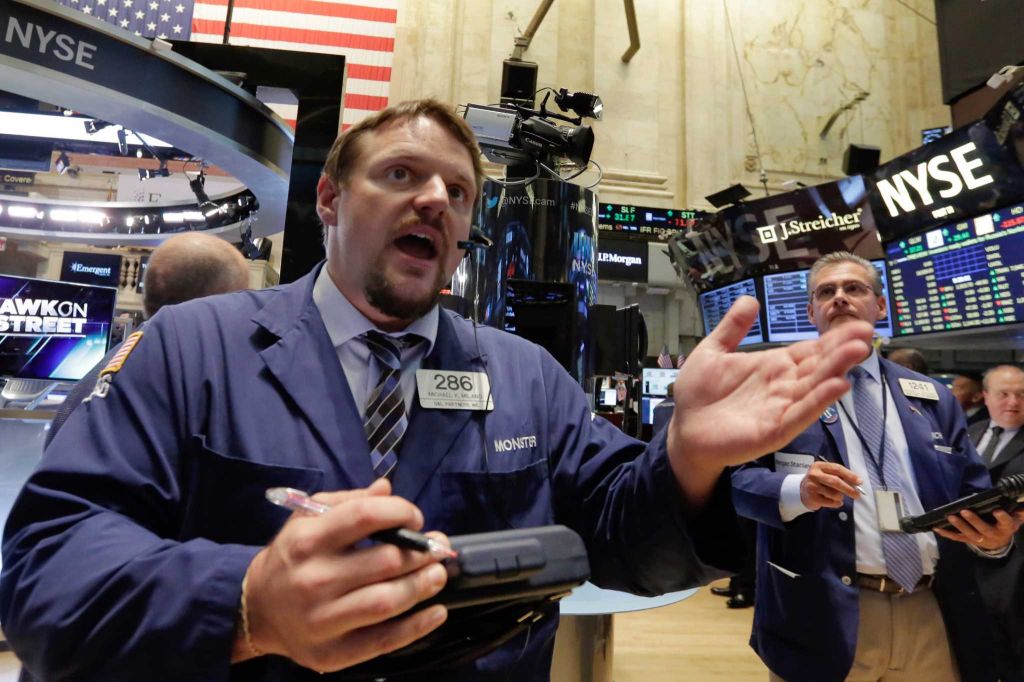- California Assembly OKs highest minimum wage in nation
- S. Korea unveils first graphic cigarette warnings
- US joins with South Korea, Japan in bid to deter North Korea
- LPGA golfer Chun In-gee finally back in action
- S. Korea won’t be top seed in final World Cup qualification round
- US men’s soccer misses 2nd straight Olympics
- US back on track in qualifying with 4-0 win over Guatemala
- High-intensity workout injuries spawn cottage industry
- CDC expands range of Zika mosquitoes into parts of Northeast
- Who knew? ‘The Walking Dead’ is helping families connect
US stocks plunge again after bleak Chinese manufacturing report

Trader Michael Milano works on the floor of the New York Stock Exchange, Tuesday, Sept. 1, 2015. More signs of weakness in China’s economy are sending global stock markets sharply lower. (AP Photo/Richard Drew)
NEW YORK (AP) — Stocks plunged again Tuesday, continuing a rocky ride for Wall Street, after an economic report out of China rekindled fears that the world’s second-largest economy is slowing more than previously anticipated.
The sell-off adds to what has been a difficult few weeks for U.S. and international markets. U.S. stocks just closed out their worst month in more than three years. Tuesday’s drop also dashed hopes that, after some relatively calm trading Friday and Monday, the stock market’s wild swings were coming to an end.
“This market remains fragile,” said Jack Ablin, chief investment officer at BMO Private Bank. “There’s nothing fundamentally wrong with the U.S. economy, but we are going through this correction process. We’ve got a rocky road ahead of us.”
Stocks started the day sharply lower and never recovered, with the Dow Jones industrial average falling as much as 548 points. No part of the market was spared. All 10 sectors of the Standard & Poor’s 500 index fell more than 2 percent. Just three stocks in the S&P 500 closed higher.
“Monday’s relatively peaceful markets are a distant memory as Chinese data and shares sparked another severe … reaction from the developed world,” said John Briggs, head of fixed income strategy at RBS.
In the end, the Dow lost 469.68 points, or 2.8 percent, to 16,058.35. The S&P 500 fell 58.33 points, or 3 percent, to 1,913.85 and the Nasdaq composite fell 140.40 points, 2.9 percent, to 4,636.10.
As it’s been for the last several weeks, the selling and problems started in Asia.
An official gauge of Chinese manufacturing fell to a three-year low last month, another sign of slowing growth in that country. The manufacturing index, which surveys purchasing managers at factories, dropped to a reading of 49.7 in August from 50.0 in July. A reading below 50 indicates a contraction.
China’s stocks sank on the news, with Shanghai Composite Index closing down 1.2 percent. The index has lost 38 percent of its value since hitting a peak in June.
The Chinese economy has been a focus for investors all summer, and the concerns have intensified in the last three weeks. China devalued its currency, the renminbi, in mid-August. Investors interpreted the move as a sign that China’s economy was not doing as well as previously reported.
Investors moved into traditional havens like bonds and gold Tuesday. Bond prices rose, pushing the yield on the benchmark 10-year Treasury note down to 2.16 percent from 2.22 percent on Monday. Gold rose $7.30, or 0.6 percent, to settle at $1,139.80 an ounce.
Faced with the possibility of slowing demand in China, the commodity markets once again took the brunt of the hit.
U.S. crude oil fell $3.79 to close at $45.41 a barrel in New York. Brent Crude, a benchmark for international oils used by many U.S. refineries, fell $4.59 to close at $49.56 in London.
Energy stocks were once again among the biggest decliners. Exxon Mobil fell nearly 4 percent and Chevron fell 2.5 percent. Exxon is down 22 percent this year, Chevron 30 percent.
In a sign of how battered energy companies have been this year, ConocoPhillips announced it was laying off 10 percent of its workers, roughly 1,800 workers, as a reaction this year’s plunge in oil prices.
Along with worries about China, speculation about whether or not the Federal Reserve will raise interest rates as soon as this month continues to weigh on markets. Traders say a lot hinges on the August jobs report, which will be released this Friday. Economists are forecasting that U.S. employers created 220,000 jobs in the month and that the unemployment rate fell to 5.2 percent.
The Federal Reserve meets September 16 and 17. Some economists are predicting that policymakers will be confident enough in the U.S. economic recovery to raise interest rates for the first time in almost a decade. While Fed officials are mostly focused on the U.S. economy, they cannot ignore problems in the global economy.
“China’s problems are totally a concern for the Fed,” said Tom di Galoma, head of rates trading at ED&F Man Capital. “With inflation remaining low here, I just don’t a reason why they would raise rates.”
Markets in Europe were broadly lower. Germany’s DAX fell 2.4 percent, France’s CAC-40 lost 2.4 percent and the U.K.’s FTSE 100 index declined 3 percent. Japan’s Nikkei 225 was also volatile, dropping 3.8 percent. The Hang Seng in Hong Kong sank 2.2 percent. Stocks also fell in South Korea and Australia.
The dollar fell to 119.68 yen from 121.20 yen on Monday. The euro rose to $1.1307 from $1.1225.
In other energy markets, wholesale gasoline fell 10.3 cents to close at $1.396 a gallon, heating oil fell 12.3 cents to close at $1.578 a gallon and natural gas rose 1.3 cents to close at $2.702 per 1,000 cubic feet.
Copper lost 4 cents to $2.30 a pound and palladium slumped $23.05 to $578.50 an ounce. The price of silver edged down four cents to $14.61 an ounce and platinum edged down $2.10 to $1,008.40 an ounce.















